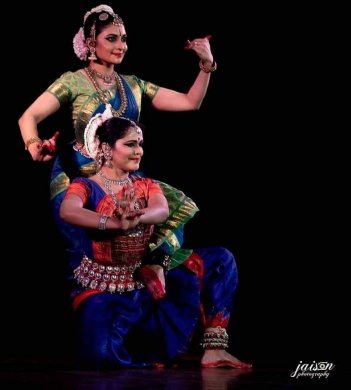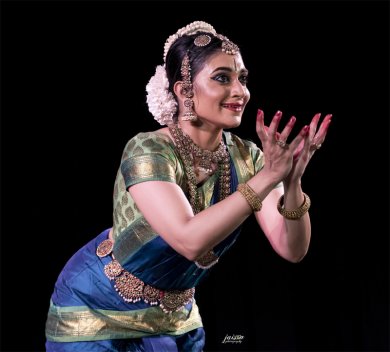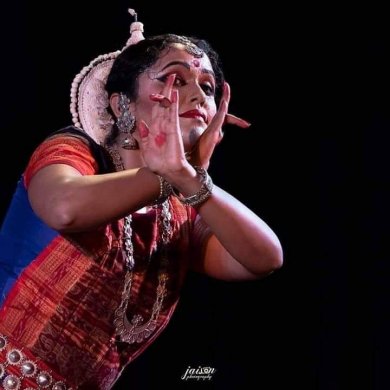
|   |

|   |
 e-mail: leelakaverivenkat@gmail.com Blend of maturity and grace in double bill concert Photos: Jaison Photography October 5, 2019 The program wing of India International Centre certainly hit the right button in its choice of Divya Ravi and Abhayalakshmi as a Bharatanatyam/Odissi twosome for the Double Bill Concert. The brief but telling invocatory duet with the starting prayer in Hamsadhwani to Vighneswara in the "Vakratunda mahakaya sooryakoti samaprabha" hymn followed by a prayer to the Goddess of learning Sharadambal in Kalyani with both dancers ending respectively with frozen postures of Mooshika with Ganesh and Saraswati on her Hamsa, gave clear indications of an evening out of the ordinary.  Divya Ravi and Abhayalakshmi Divya Ravi based in Bengaluru who after her Bharatanatyam arangetram in 2008, was involved with Kathak under Nirupama Rajendra - before homing back to Bharatanatyam (after having qualified as a full- fledged Engineer ) - this time under Guru Dr. Soundarya Srivatsa, commenced her Bharatanatyam recital with a Melaprapti in raga Bhatiyar, composed by Rohit Bhatt. The dancer interpreted a temple visit as a sensory delight with the sounds of music and percussion and the bell, the fragrance of flowers and incense, skin tingling with the touch of the camphor flame, the eyes drinking in the sight of the deity in the altar with the taste buds finally kindled by sampling the 'Prasad' - the kindling and awakening of the five senses set to the panchanadai with the rhythmic combinations of 3,4,5, 7 and 9 composed by Srihari Rangaswamy, very intelligently choreographed by the dancer and what is more, performed with skill and involvement.  Divya Ravi The redoubtable padavarnam, choreographed by Divya's guru Soundarya, was based on a composition of Lalgudi Jayaraman "Angaiyar kanni aanandam kondale," a Navarasa Navaragamalika woven round deity Meenakshi visualized in situations evoking nine moods or rasas. She is the embodiment of valour or veera rasa in the Pallavi (in raga Bilahari) as charging in her chariot drawn by horses, this martial deity vanquishes enemies. Set to Usseni was the Anupallavi statement portraying the segment wherein Meenakshi loses her heart to Shiva, her love not swerved by the Lord testing her in the guise of an ascetic wanting to know what she sees in one with matted hair, covered in ash, draped in a tiger skin and garlanded with a snake. Adbhutam set to raga Valachi saw the goddess struck with wonderment at the way Manmatha was reduced to ashes and at Shiva's Tripurasamhara feat. In raga Saranga was the Hasya or merriment of Parvati as she sees Shiva disguised as a mere labourer, display singing prowess that has no equal. The charanam line in Rucharitra shows the Devi's disgust (Bibhatsam) at her father's treatment of Shiva. Set to raga Atthana was the angry goddess as Kali, Kapalini and other manifestations donned to destroy evil. The next charanam segment showed Parvati's fear on seeing Shiva swallow the accumulated poison from Vasuki's breath in the sea being churned for ambrosia and also when her home Mt Kailash was lifted and tossed about by the arrogant Ravana. This part was in Rasikapriya. Shahana raga painted the Devi's compassion and finally Shantam in raga Nadanamakriya saw the Devi in perfect equanimity of tranquility. While Srivatsa's singing was excellent, the total control on both nritta and abhinaya in the dancer, whose expressional interpretation full of conviction never took recourse to exaggeration even in the more animated moments of showing anger or disgust or fear, spoke of a maturity in understanding the dance idiom. The Bharatanatyam finale again saw Divya's own interpretation of an Eknath Abhanga in Marathi, the music composition by Rohit Bhatt, comprising five milkmaids draped in five different colours, white like the dazzling moonlight, yellow like Spring in full bloom, a majestic black, a vermilion red and a green like the peacock feathers. They ultimately represent many manifestations of that one state-of- being to become one with the Lord. And with what conviction Divya at once caught the regional feel of Maharashtra in her persona wearing the nath on her nose! Her dance translated the outward joy and colour in all the variety - finally subsumed in that oneness of attaining that state of the jeeva merging in the paramatma.  Abhayalakshmi Following, after a hard act to emulate, Odissi performer Abhayalakshmi, who has worked with Bharatanatyam gurus like Shankar Kandaswamy and others and is now under the tutelage of Sharmila Mukerjee in Odissi, acquitted herself well. Her performance 'Nritya Dhara' sought to bring out items featuring the three main schools of Odissi under their respective founders, Pankaj Charan Das, Debaprasad Das and Kelucharan Mohapatra in that order. The Pallavi in Shankarabharanam set to Ektali composed by late Pankaj Charan Das, right from the starting "Ta jhena ta inda jhenuta…" had a beauty in simplicity, both melodic sweetness which stirred the listener no end, and the sway in the tune which went so perfectly with the bodily genuflexions making for a matching delight. There was no attempt at any sort of rhythmic cleverness. The dancer stuck to the very straightforward Ektali as set by the music. With a different sort of enchantment was the next Banamali Das composition, a choreography of late Debaprasad Das. In raga Khamaach set to Ektali, "Keelo sajani, keli kadamba mule" the mugdha nayika exchanges with her friend, the unforgettable beauty of what she had witnessed under the shade of the Kadamba tree, where Krishna sported with the Gopis. "Who is the one under that tree?" she had wondered. She would not find fault with any woman for being drawn to such an attractive presence, bound to make one forget vows of 'pativrita.' Again both music sung by Sukant Kumar Kundu and the dance interpretation by Guru Debaprasad went hand in hand and the dancer's presentation showed coming to grasps with the regional flavor. For the Kelucharan Mohapatra style, which is very distinctive in its nritta, the dancer however chose an abhinaya number based on the Gita Govinda ashtapadi "Keshi mathanam Udaram" and Bhubaneswar Misra's music in Misra Pahadi was redolent with that ability to match word and its emotive content with melody in a way which seemed to wring out the last bit of feeling from the sahitya. Abhayalakshmi's presentation while fair, has yet to grasp the full worth of the poetry describing abhisarika Radha's deep longing for Krishna even as she recollects the first intimate encounter and how Krishna had helped her conquer shyness of inexperience. The last item saw the dancer's own choreography - the theme as one belonging to the South being woven round the Goddess Meenakshi, born with three breasts out of the sacrificial fire to Malayadhwaja Pandya Raja. Reared as a warrior to rule the Kingdom, her third breast disappears as soon as she loses her heart to Shiva as Sundarar and the item ends with her wedding to Sundarar. Roshini Iyer's guidance with the text in Sanskrit, with music scored by Odisha's well known classical singer Bijay Jena provided the base for the item. Despite Jena's redoubtable expertise, the music with the sahitya sounded a trifle forced and the natural flow of melody with text seen in the rest of the recital was totally missing. Cultural identity operates at several levels and while sourcing different aspects of production to different experts, the blend can lack that alchemy of that inexplicable something which defines a dance tradition.  Writing on the dance scene for the last forty years, Leela Venkataraman's incisive comments on performances of all dance forms, participation in dance discussions both in India and abroad, and as a regular contributor to Hindu Friday Review, journals like Sruti and Nartanam, makes her voice respected for its balanced critiquing. She is the author of several books like Indian Classical dance: Tradition in Transition, Classical Dance in India and Indian Classical dance: The Renaissance and Beyond. Post your comments Please provide your name and email id when you use the Anonymous profile in the blog to post a comment. All appropriate comments posted with name and email id in the blog will also be featured in the site. |